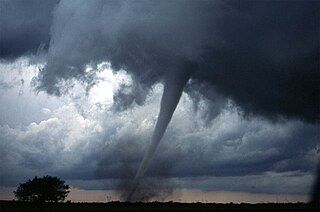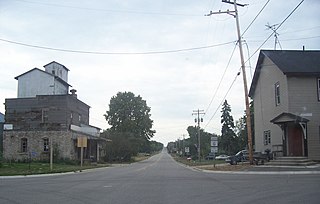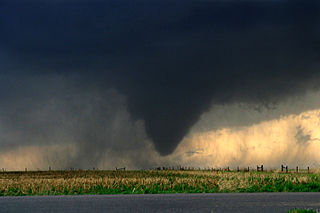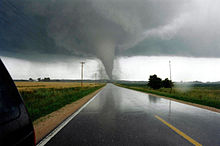
A tornado is a violently rotating column of air that is in contact with both the surface of the Earth and a cumulonimbus cloud or, in rare cases, the base of a cumulus cloud. It is often referred to as a twister, whirlwind or cyclone, although the word cyclone is used in meteorology to name a weather system with a low-pressure area in the center around which, from an observer looking down toward the surface of the Earth, winds blow counterclockwise in the Northern Hemisphere and clockwise in the Southern. Tornadoes come in many shapes and sizes, and they are often visible in the form of a condensation funnel originating from the base of a cumulonimbus cloud, with a cloud of rotating debris and dust beneath it. Most tornadoes have wind speeds less than 180 kilometers per hour, are about 80 meters across, and travel several kilometers before dissipating. The most extreme tornadoes can attain wind speeds of more than 480 kilometers per hour (300 mph), are more than 3 kilometers (2 mi) in diameter, and stay on the ground for more than 100 km (62 mi).

A supercell is a thunderstorm characterized by the presence of a mesocyclone, a deep, persistently rotating updraft. Due to this, these storms are sometimes referred to as rotating thunderstorms. Of the four classifications of thunderstorms, supercells are the overall least common and have the potential to be the most severe. Supercells are often isolated from other thunderstorms, and can dominate the local weather up to 32 kilometres (20 mi) away. They tend to last 2–4 hours.

From May 2 to 8, 1999, a large tornado outbreak took place across much of the Central and parts of the Eastern United States, as well as southern Canada. During this week-long event, 152 tornadoes touched down in these areas. The most dramatic events unfolded during the afternoon of May 3 through the early morning hours of May 4 when more than half of these storms occurred. Oklahoma experienced its largest tornado outbreak on record, with 70 confirmed. The most notable of these was the F5 Bridge Creek–Moore tornado which devastated Oklahoma City and suburban communities. The tornado killed 36 people and injured 583 others; losses amounted to $1 billion, making it the first billion-dollar tornado in history. Overall, 50 people lost their lives during the outbreak and damage amounted to $1.4 billion. For these reasons, the outbreak is known in Oklahoma as the May 3rd outbreak or the Oklahoma tornado outbreak of 1999.

The 1990 Plainfield tornado was a devastating tornado that occurred on the afternoon of Tuesday, August 28, 1990. The violent tornado killed 29 people and injured 353. It is the only F5/EF5 rated tornado ever recorded in August in the United States, and the only F5 tornado to strike the Chicago area. There are no known videos or photographs of the tornado itself; however, in 2011, a video surfaced online showing the supercell that spawned the tornado. The Plainfield tornado was part of a small outbreak that produced several tornadoes in the Northern United States, specifically Kansas, and the Canadian province of Ontario.

This article lists various tornado records. The most "extreme" tornado in recorded history was the Tri-State tornado, which spread through parts of Missouri, Illinois, and Indiana on March 18, 1925. It is considered an F5 on the Fujita Scale, holds records for longest path length at 219 miles (352 km), longest duration at about 3+1⁄2 hours, and it held the fastest forward speed for a significant tornado at 73 mph (117 km/h) anywhere on Earth until 2021. In addition, it is the deadliest single tornado in United States history with 695 fatalities. It was also the third most costly tornado in history at the time, when costs are normalized for wealth and inflation, it still ranks third today.

The 1985 United States–Canada tornado outbreak, referred to as the Barrie tornado outbreak in Canada, was a major tornado outbreak that occurred in Ohio, Pennsylvania, New York, and Ontario, on May 31, 1985. In all 44 tornadoes were counted including 14 in Ontario, Canada. It is the largest and most intense tornado outbreak ever to hit this region, and the worst tornado outbreak in Pennsylvania history in terms of deaths and destruction.

This page documents notable tornadoes and tornado outbreaks worldwide in 2006. Strong and destructive tornadoes form most frequently in the United States, Bangladesh, and Eastern India, but they can occur almost anywhere under the right conditions. Tornadoes also develop occasionally in southern Canada during the Northern Hemisphere's summer and somewhat regularly at other times of the year across Europe, Asia, Argentina, Brazil and Australia. Tornadic events are often accompanied with other forms of severe weather, including strong thunderstorms, strong winds, and hail.
There is a long history of destructive tornadoes in the St. Louis metropolitan area. The third-deadliest, and the costliest in United States history, the 1896 St. Louis–East St. Louis tornado, injured more than one thousand people and caused at least 255 fatalities in the City of St. Louis and in East St. Louis. The second-costliest tornado also occurred in St. Louis in September 1927. More tornado fatalities occurred in St. Louis than any other city in the United States. Also noteworthy is that destructive tornadoes occur in winter and autumn, as well as the typical months of spring. Additionally, damaging tornadoes occur in the morning and late at night, as well as the more common late afternoon to early evening maximum period.

The Tornado outbreak of June 14–18, 1992 was one of the largest tornado outbreaks on record, affecting portions of the Central United States from June 14 to June 18, 1992. The outbreak began on June 14 when six tornadoes touched down in Colorado and Idaho. Fifty-eight tornadoes were reported across portions of the Great Plains on June 15, and 65 more were reported over much of the central U.S. on June 16. The 123 tornadoes that touched down on June 15–16 make that two-day span the 5th largest two-day tornado outbreak in U.S. history behind the 1974 Super Outbreak, the May 2004 tornado outbreak sequence, the tornado outbreak of April 14–16, 2011, and the 2011 Super Outbreak. Twenty-eight more tornadoes touched down on June 17, and 13 more touched down on June 18, giving this outbreak 170 confirmed tornadoes.

This page documents the tornadoes and tornado outbreaks that occurred in 2007, primarily in the United States. Most tornadoes form in the U.S., although some events may take place internationally, particularly in parts of neighboring southern Canada during the summer season. Some tornadoes also take place in Europe, e. g. in the United Kingdom or in Germany.

This page documents the tornadoes and tornado outbreaks of 2002, primarily in the United States. Most tornadoes form in the U.S., although some events may take place internationally. The year had several large outbreaks that included the Veterans Day Weekend tornado outbreak and the Midwest to Mid-Atlantic United States tornado outbreak.

Marytown, Wisconsin is an unincorporated community in Fond du Lac County, Wisconsin, in the town of Calumet. Marytown is located at the intersection of Fond du Lac County highways G and HH. Wisconsin Highway 149, ran north to south through the community before it was decommissioned in 2006.

The Tornado outbreak of June 7–8, 1984 was a significant severe weather and tornado event that took place across the central United States from North Dakota to Kansas on June 7–8, 1984. The tornado outbreak produced several significant tornadoes including an F5 tornado which traveled through Barneveld, Wisconsin, in the early hours of June 8, 1984. The entire outbreak killed at least 13 people across three states including 9 in Barneveld alone.

A multi-day tornado outbreak affected the central plains of the United States from May 22–27, 2008. It was also one of the largest continuous tornado outbreaks on record. A total of 173 tornadoes were confirmed, with the most intense activity occurring across the Great Plains. One person was killed when a large wedge tornado struck Windsor, Colorado, and two more deaths were reported in Pratt County, Kansas. One person was also killed near Hugo, Minnesota on May 25 and nine were killed by an EF5 tornado that destroyed most of Parkersburg, Iowa and a small subdivision of New Hartford, Iowa. Another fatality, caused by lightning related to the storms, occurred in central Kansas.

This page documents the tornadoes and tornado outbreaks of 1996, primarily in the United States. Most tornadoes form in the U.S., although some events may take place internationally. Tornado statistics for older years like this often appear significantly lower than modern years due to fewer reports or confirmed tornadoes, however by the 1990s tornado statistics were coming closer to the numbers we see today.

This page documents the tornadoes and tornado outbreaks of 1998, primarily in the United States. Most tornadoes form in the U.S., although some events may take place internationally. Tornado statistics for older years like this often appear significantly lower than modern years due to fewer reports or confirmed tornadoes, however by the 1990s tornado statistics were coming closer to the numbers we see today.

The 1999 Bridge Creek–Moore tornado was a large, long-lived and exceptionally powerful F5 tornado in which the highest wind speeds ever measured globally were recorded at 135 metres per second by a Doppler on Wheels (DOW) radar. Considered the strongest tornado ever recorded to have affected the metropolitan area, the tornado while near peak intensity devastated southern portions of Oklahoma City, Oklahoma, United States, along with surrounding suburbs and towns to the south and southwest of the city during the early evening of Monday, May 3, 1999. Parts of Bridge Creek were rendered unrecognizable. The tornado covered 38 miles (61 km) during its 85-minute existence, destroying thousands of homes, killing 36 people, and leaving US$1 billion in damage, ranking it as the fifth-costliest on record not accounting for inflation. Its severity prompted the first-ever use of the tornado emergency statement by the National Weather Service.

This page documents the tornadoes and tornado outbreaks of 2011. Extremely destructive tornadoes form most frequently in the United States, Bangladesh, Brazil and Eastern India, but they can occur almost anywhere under the right conditions. Tornadoes also appear regularly in neighboring southern Canada during the Northern Hemisphere's summer season, and somewhat regularly in Europe, Asia, and Australia.

During the afternoon of April 27, 2011, a violent EF5 tornado touched down in eastern Mississippi, killing three people. Part of the historic 2011 Super Outbreak, the largest tornado outbreak on record, this was the first of four EF5 tornadoes to touch down that day and the first such storm in Mississippi since the 1966 Candlestick Park tornado. While on the ground for 30 minutes, it traveled along a 28.28-mile (45.51 km) path through four counties, leaving behind three deaths, eight injuries, and $1.1 million in damage.



















